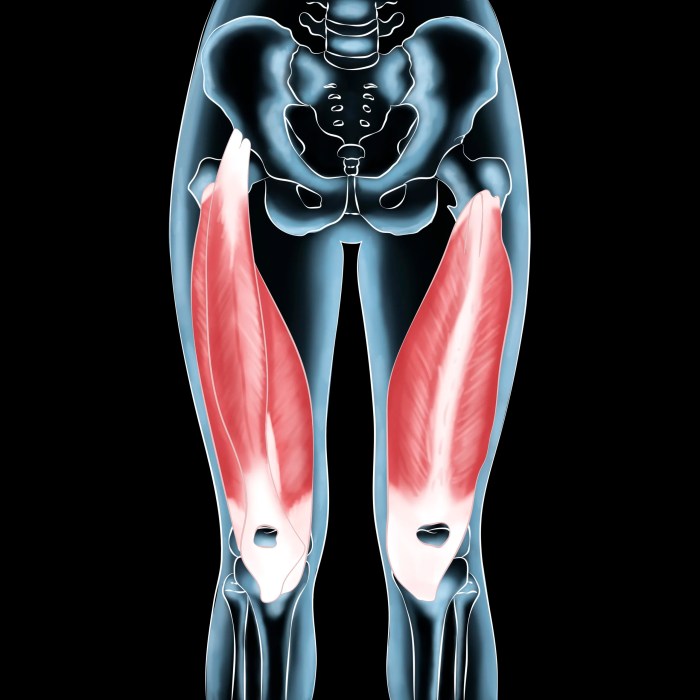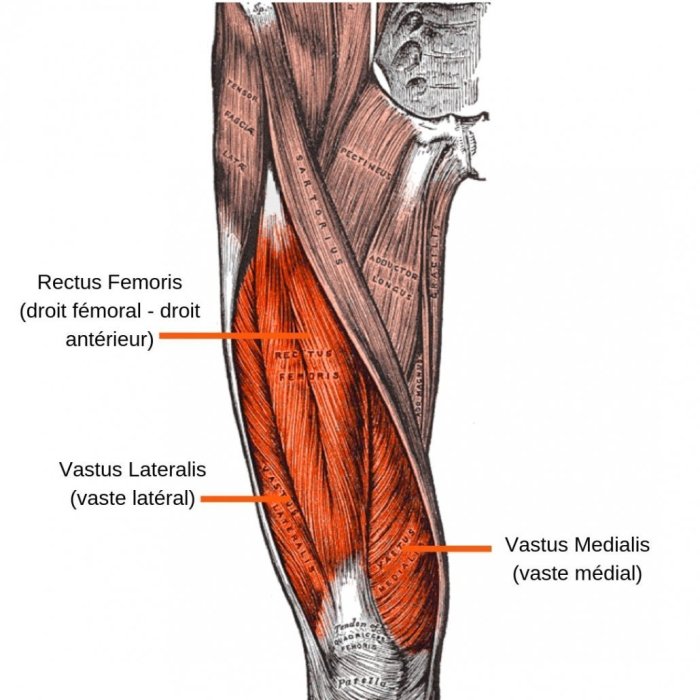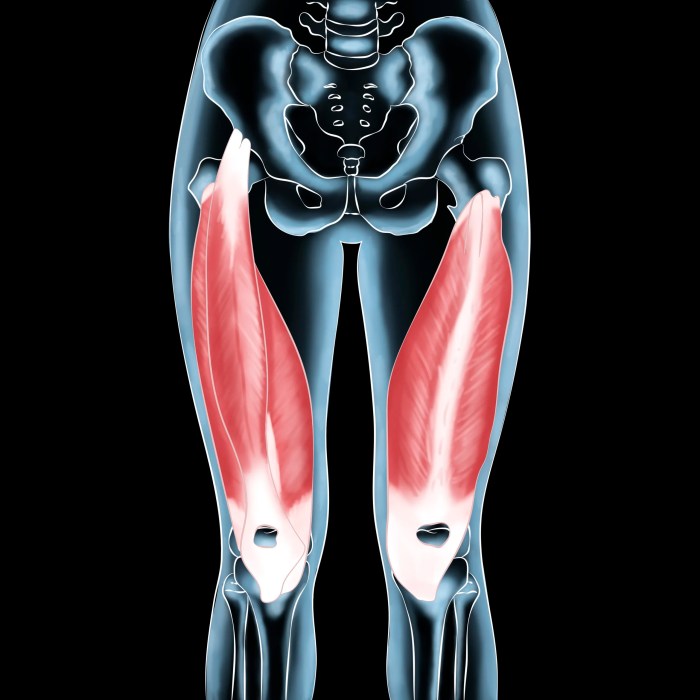Short arc quad exercise is a targeted movement designed to strengthen and sculpt your quads. This exercise, often used in rehabilitation and strength training, focuses on controlled movements to maximize muscle activation. We’ll explore its variations, benefits, proper form, and safety considerations to ensure you get the most out of this powerful exercise.
This comprehensive guide covers everything from the fundamentals of the short arc quad exercise to advanced variations and progressions. We’ll also discuss important safety precautions and common mistakes to avoid, ensuring you can incorporate this exercise safely and effectively into your workout routine.
Overview of Short Arc Quad Exercise
The short arc quad exercise is a targeted strength training movement specifically designed to isolate and strengthen the quadriceps muscles, a crucial muscle group for various lower body activities. It’s particularly useful for rehabilitation and injury prevention, as well as for building strength and muscle definition in the quadriceps. This focused approach helps in building strength while reducing stress on the surrounding joints.This exercise effectively works the quadriceps muscles through a controlled range of motion, enabling users to progressively increase resistance and intensity.
Understanding the variations, biomechanics, and proper technique is essential to maximize the exercise’s effectiveness and minimize the risk of injury.
Exercise Description
The short arc quad exercise involves a controlled, limited range of motion, primarily focused on the quadriceps femoris. This controlled movement helps to isolate the targeted muscle group, allowing for focused strengthening and preventing strain on supporting structures. The emphasis on a limited range of motion is crucial for maintaining proper form and maximizing muscle activation.
Short arc quad exercises are great for building strength, but sometimes accidents happen. If you get a cut, knowing how to treat a laceration properly is crucial. For example, if you accidentally nick yourself while doing these exercises, following the steps in this guide on how to treat a laceration can help prevent infection and ensure a speedy recovery.
Getting back to your short arc quad routine should be a priority after taking care of the wound.
Variations
While the core exercise remains the same, variations can be introduced to adjust the intensity and target different aspects of the quadriceps. Variations include using different resistance levels (e.g., dumbbells, resistance bands), and adjusting the angle of the arc. Each variation subtly alters the muscle activation patterns and the overall stress placed on the joint. For example, using a resistance band will offer less resistance compared to free weights.
This difference is crucial to consider when tailoring the exercise to individual needs.
Biomechanics
The biomechanics of the short arc quad exercise hinge on the controlled contraction of the quadriceps femoris muscle group. The primary action is knee extension, with the rectus femoris, vastus lateralis, vastus medialis, and vastus intermedius muscles working synergistically to straighten the knee joint. This coordinated action is critical for effective strength development. The controlled movement pattern also minimizes stress on the patellofemoral joint.
Step-by-Step Procedure
- Begin by positioning yourself on a bench or similar elevated surface. Ensure the elevation is stable and appropriate for your height and strength level.
- Position your leg so that your knee is bent, and the lower leg is supported. A firm support is essential for maintaining balance and control.
- Slowly extend your knee, maintaining a controlled motion. The movement should be gradual, ensuring no sudden jerks.
- Continue the extension until your knee is almost fully extended, then slowly return to the starting position.
- Repeat the process for the desired number of repetitions. Consistency and proper form are essential for optimal results.
Common Mistakes to Avoid
- Using momentum: Avoid using momentum to propel the leg; this can lead to injury and reduce the effectiveness of the exercise. Focus on controlled, slow movements. Incorporate rest periods between sets to maintain proper form and prevent strain.
- Failing to maintain proper alignment: Maintain a neutral spine and a stable body position to prevent strain on the back and other supporting structures. Improper alignment can lead to compensation from other muscle groups, reducing the efficacy of the exercise.
- Overextending the knee: Avoid extending the knee beyond a comfortable range of motion. This can lead to joint stress. A controlled range of motion is essential for maintaining joint health.
- Using excessive weight: Start with a manageable weight and gradually increase as strength improves. Using excessive weight can lead to poor form and potential injury. Listen to your body and avoid pushing through pain.
Benefits of Short Arc Quad Exercise
The short arc quad exercise, a targeted movement focusing on the quadriceps, offers a unique approach to strengthening and conditioning this crucial muscle group. Understanding its benefits can help you integrate this exercise effectively into your workout routine, optimizing results and potentially preventing injuries.This exercise excels at improving the function and activation of the quadriceps muscles. It isolates the targeted muscle group, allowing for greater control and precision during the movement, leading to more effective and efficient muscle growth.
The controlled nature of the movement also minimizes stress on other joints, making it a safe and effective option for individuals of various fitness levels.
Strength and Power Enhancement
The short arc nature of the exercise allows for a higher volume of repetitions compared to traditional exercises. This increased repetition range, within a controlled and safe arc, facilitates greater muscle fatigue and subsequent adaptation. This enhanced fatigue promotes hypertrophy and the development of muscular strength. The focused contraction and controlled movement also enhance power output, making it beneficial for athletes seeking to improve explosive movements.
Injury Prevention and Muscle Activation
By isolating the quadriceps and focusing on a controlled range of motion, the short arc exercise minimizes the risk of strain or injury to surrounding muscles and joints. This is particularly important for individuals who may have pre-existing knee conditions or those recovering from injuries. The exercise’s precision enhances neuromuscular control, leading to improved activation and function of the quadriceps, crucial for maintaining proper joint stability.
Mobility and Flexibility Improvements
The short arc exercise, when performed correctly, can contribute to improved quadriceps flexibility and mobility. The controlled nature of the movement and the emphasis on specific muscle activation encourage a more dynamic range of motion. By targeting specific muscle fibers, it can contribute to increased flexibility in the quadriceps, allowing for better movement patterns in daily activities.
Comparison to Other Exercises, Short arc quad exercise
Compared to traditional leg press exercises or squats, the short arc quad exercise offers a higher degree of isolation and control. This precision allows for a more targeted approach to quadriceps strengthening, potentially leading to greater strength gains in the specific muscle group. Leg extensions, while isolating the quads, may not always offer the same controlled range of motion and the focus on functional movements inherent in the short arc exercise.
Furthermore, the short arc quad exercise often allows for a higher repetition range, which is critical for muscle hypertrophy and strength development.
Physiological Adaptations
Consistent practice of the short arc quad exercise can lead to a range of physiological adaptations. These adaptations include increased muscle fiber size (hypertrophy), enhanced neuromuscular coordination, and improved blood flow to the targeted muscle groups. Over time, these adaptations contribute to increased strength, power, and overall functional capacity. Real-world examples include athletes who need to improve their explosive leg movements, or individuals seeking to rehabilitate injuries involving the quadriceps.
Consistent training can lead to measurable increases in strength and power output, demonstrating the effectiveness of the exercise.
Proper Form and Technique
Mastering the short arc quad exercise hinges on impeccable form. Incorrect technique can lead to injuries and hinder progress. Understanding the precise movements and anatomical landmarks is crucial for optimal results. This section will detail the proper form, highlighting key points for maintaining safety and maximizing effectiveness.Proper form during the short arc quad exercise is paramount to preventing injuries and ensuring effective muscle engagement.
Maintaining a stable and controlled movement pattern throughout the exercise is key to achieving the intended results.
Starting Position
Establishing the correct starting position is the cornerstone of safe and effective exercise execution. Maintaining a neutral spine and engaged core muscles is vital for maintaining stability and preventing strain on the lower back. This ensures that the exercise focuses on the targeted quadriceps muscles and not other muscle groups. Stand with feet shoulder-width apart, knees slightly bent, and maintain a relaxed posture.
Imagine a slight hollow in your lower back; avoid arching or rounding your spine.
Movement Execution
The controlled movement is the essence of the short arc quad exercise. This controlled motion is essential to avoid straining the joints and promotes targeted muscle activation. Maintain a slow and deliberate pace. Ensure your movement is focused on the quadriceps muscles, avoiding momentum or jerking motions. The controlled movement will prevent strain on supporting joints and ensure targeted muscle contraction.
Ending Position
The concluding position should maintain the integrity of the body and ensure optimal muscle engagement. Ensure that the exercise is concluded with a controlled movement, avoiding sudden stops or jerky movements. The ending position should maintain the posture established in the starting position, providing a stable conclusion to the exercise.
Critical Points Table
| Stage | Description | Image Description |
|---|---|---|
| Starting Position | Feet shoulder-width apart, knees slightly bent, back straight, core engaged. Maintain a neutral spine. | A person standing with feet shoulder-width apart, knees slightly flexed, back straight, and core engaged. The shoulders are relaxed and the gaze is forward. |
| Movement | Slowly bend the knees, keeping the back straight and core engaged. Maintain a controlled movement. Focus on the quadriceps muscles during the exercise. | A person smoothly bending their knees while keeping their back straight and core tight. The movement is slow and controlled, emphasizing the quadriceps muscle engagement. |
| Ending Position | Slowly extend the knees to return to the starting position. Maintain a controlled movement. | A person extending their knees to return to the starting position, ensuring a smooth transition and maintaining core engagement. |
Importance of Controlled Movements
Controlled movements are crucial for preventing injuries. Jerky or uncontrolled movements can place undue stress on joints, potentially leading to strains, sprains, or other musculoskeletal issues. Controlled movements help target the desired muscle group, preventing the engagement of surrounding muscles.
Adjustments for Strength and Flexibility
Adjustments are essential to cater to individual needs and progress. If you are a beginner, start with a lower number of repetitions or a lighter resistance. If you are more experienced, you can progressively increase the resistance. For individuals with limited flexibility, consider modifications like using a chair or wall for support.
Progressive Overload
Progressive overload is vital for maximizing results. Gradually increase the intensity or resistance over time. This could involve increasing the number of repetitions, sets, or the weight lifted. As you get stronger, you can progressively overload the exercise to continue challenging your muscles.
Safety Considerations and Precautions

Proper form and technique are crucial for minimizing risk during any exercise, and the short arc quad exercise is no exception. Understanding potential hazards and implementing preventative measures is paramount to ensuring a safe and effective workout. By acknowledging potential risks and adopting appropriate precautions, you can maximize the benefits of this exercise while minimizing the chance of injury.Safety is paramount when performing any exercise, especially when targeting specific muscle groups like the quadriceps.
Failing to prioritize safety can lead to detrimental consequences, including painful injuries that may hinder your training progress and overall well-being. This section delves into essential safety considerations to ensure your workout is both effective and risk-free.
Potential Risks and Precautions
Understanding the potential risks associated with the short arc quad exercise is vital for injury prevention. Incorrect form, inadequate warm-up, or pushing beyond your limits can lead to several potential issues. Always listen to your body and stop if you experience pain. It is always better to err on the side of caution.
- Improper Form: Incorrect technique during the exercise can strain muscles and ligaments. This can lead to acute injuries such as muscle tears or sprains. Consistent practice with proper form is crucial.
- Overexertion: Pushing yourself beyond your physical capabilities can result in delayed-onset muscle soreness (DOMS) or more severe injuries. Gradually increase the intensity and duration of your workouts to allow your body to adapt.
- Lack of Warm-up: Insufficient warm-up can increase the risk of muscle strains or tears. A proper warm-up prepares your muscles for the demands of the exercise.
- Underlying Medical Conditions: Individuals with pre-existing knee or hip conditions should consult their physician before starting this exercise. Modifications may be necessary to prevent exacerbating any existing issues.
- Equipment Malfunction: Ensure the equipment you’re using is in good working order and stable. Any equipment defects can compromise safety.
Common Injuries and Prevention
Knowing the common injuries associated with this exercise allows for proactive injury prevention.
- Muscle Strains/Tears: These injuries often occur due to improper form, overexertion, or insufficient warm-up. Strengthening exercises targeting the quadriceps and surrounding muscles can help prevent these issues. Stretching before and after the exercise is crucial.
- Ligament Sprains (e.g., ACL): While less common with this exercise, improper form can still place stress on ligaments. Maintaining proper alignment and technique during the exercise minimizes the risk of ligament sprains.
- Patellofemoral Pain Syndrome (Runner’s Knee): Overuse or improper form can cause irritation around the kneecap. Consistent form, gradually increasing intensity, and adequate rest periods are vital in preventing this.
- Knee Joint Injuries: Exercises that put stress on the knee joint can result in cartilage damage or meniscus tears. Careful attention to form, gradual progression, and proper warm-up routines can help mitigate the risk.
Warm-up and Cool-down Routines
A structured warm-up and cool-down are essential to prepare your body for the exercise and facilitate recovery. These routines help prevent injuries and promote optimal performance.
| Phase | Activities |
|---|---|
| Warm-up | Light cardio (e.g., brisk walking), dynamic stretching (e.g., leg swings, hip circles), and quad-specific stretches (e.g., leg raises, hamstring stretches). |
| Cool-down | Static stretching (e.g., holding hamstring stretches, quad stretches), light cardio (e.g., slow walking), and foam rolling to promote blood flow and reduce muscle soreness. |
Breathing Techniques
Proper breathing techniques are crucial for maintaining optimal performance and preventing injuries during the short arc quad exercise.
Proper breathing during exercise is not just about inhaling and exhaling; it’s about synchronizing your breath with your movements.
Maintaining a steady and controlled breathing pattern during the exercise can improve oxygen intake, reducing the risk of muscle fatigue and potential injury.
Modifications for Specific Limitations
Individuals with specific limitations or injuries may need modifications to the short arc quad exercise to ensure safety and effectiveness.
- Knee Injuries: Individuals with knee injuries should consult with a physical therapist or physician before performing the exercise. Modifications may involve using lighter weights, altering the range of motion, or performing alternative exercises. Focus on exercises that do not exacerbate the injury.
- Hip Pain: Adjust the exercise by ensuring a neutral hip position throughout the movement. Modifications could involve using resistance bands or focusing on controlled movements to avoid placing excessive stress on the hip joint.
- Limited Mobility: Individuals with limited mobility can modify the exercise by performing it with reduced range of motion or using assistive devices. Focus on controlled movements and ensuring proper alignment.
Variations and Progressions
Taking the short arc quad exercise to the next level involves exploring variations that increase the challenge and target different aspects of the quadriceps muscles. These modifications allow you to progressively build strength and endurance, tailor the exercise to your current fitness level, and prevent plateaus in your training. Understanding how to modify the exercise appropriately ensures safe and effective results.Different variations of the short arc quad exercise allow you to increase the difficulty and target different aspects of the quadriceps muscles.
This helps you progressively build strength and endurance, tailor the exercise to your current fitness level, and prevent plateaus in your training. The key is to gradually increase the challenge while maintaining proper form.
Variations for Increased Difficulty
The progression from a basic to an advanced variation of the short arc quad exercise typically involves increasing resistance, altering the range of motion, or adding instability. These adjustments ensure you’re continually challenging your muscles and improving your overall strength and conditioning.
Resistance Band Variations
Incorporating resistance bands into the short arc quad exercise offers a straightforward way to add intensity. Loop the band around your feet, holding the handles, and perform the exercise as you would without the band. This approach progressively increases the load on your quadriceps, promoting stronger muscle activation and increased endurance. You can progressively increase resistance by choosing bands with higher resistance levels.
Surface Variations
Altering the surface on which you perform the exercise can significantly impact the difficulty and effectiveness of the short arc quad exercise. Performing the exercise on an incline or decline surface modifies the range of motion and activation patterns, allowing for a more challenging and specific training stimulus.
| Variation | Description | Difficulty Level |
|---|---|---|
| Basic Short Arc Quad | Standard exercise on a flat surface. | Beginner |
| Resistance Band Short Arc Quad | Incorporates resistance bands around the feet for added intensity. | Intermediate |
| Short Arc Quad on Incline | Performing the exercise on a slightly inclined surface. | Intermediate |
| Short Arc Quad on Decline | Performing the exercise on a slightly declined surface. | Intermediate to Advanced |
| Single-Leg Short Arc Quad | Performing the exercise on one leg for increased stability and balance challenges. | Intermediate to Advanced |
Progression Examples
Moving from a beginner to an intermediate level, you can progressively increase resistance. For instance, starting with bodyweight and then incorporating resistance bands. Moving to an advanced level, you can increase the incline or decline angle, or add instability by performing the exercise on a single leg. These progressions allow you to continuously challenge your muscles and optimize your training for desired results.
Exercise Programming and Integration: Short Arc Quad Exercise
Integrating the short arc quad exercise into a comprehensive workout routine requires careful consideration of your fitness goals, current abilities, and overall training program. This approach ensures the exercise contributes positively to your progress without risking injury or stagnation. Properly planned routines maximize results while respecting individual limitations.The key to successful exercise programming is understanding how the short arc quad exercise fits into your overall training plan.
A well-structured program will help you achieve your fitness goals safely and effectively. This section delves into designing workout routines tailored to different needs, highlighting the role of the short arc quad exercise in various training contexts.
Sample Workout Routines
This section presents example workout routines that incorporate the short arc quad exercise. These routines are designed to provide a framework, and you can adjust them based on your individual needs and preferences.
- Beginner Routine (2-3 times per week): This routine focuses on building a base level of strength and endurance. It incorporates the short arc quad exercise with other fundamental lower body movements, allowing for progressive overload as you advance.
- Intermediate Routine (3-4 times per week): This routine increases the frequency and intensity of the short arc quad exercise while incorporating more complex movements. It aims to challenge your body further and promote strength gains.
- Advanced Routine (4-5 times per week): This routine is designed for experienced lifters seeking maximal gains in quad strength and power. It utilizes higher volumes, heavier weights, and more advanced variations of the short arc quad exercise.
Exercise Frequency, Sets, Reps, and Rest Periods
A structured approach to exercise programming involves establishing clear guidelines for frequency, sets, reps, and rest periods. This table presents a general framework; however, you should adjust these parameters based on your individual progress and recovery.
| Exercise | Frequency (per week) | Sets | Reps | Rest (minutes) |
|---|---|---|---|---|
| Short Arc Quad Exercise | 2-3 | 3-4 | 8-12 | 1-2 |
| Leg Press | 2-3 | 3-4 | 10-15 | 1-2 |
| Bulgarian Split Squat | 2-3 | 3-4 | 8-12 per leg | 1-2 |
| Hamstring Curls | 2-3 | 2-3 | 10-15 | 1-2 |
Workout Plans for Different Fitness Goals
Tailoring workout plans to specific fitness goals is crucial for maximizing results. This section highlights how the short arc quad exercise can be integrated into routines designed for various objectives.
- Strength Training: Focus on progressively heavier weights with fewer repetitions to maximize strength gains. The short arc quad exercise can be a key component in this approach, allowing for targeted quadriceps development.
- Power Training: Incorporate explosive movements and shorter rest periods. The short arc quad exercise, when performed explosively, can enhance power output. For example, a routine could involve plyometrics or jump squats alongside the short arc quad exercise.
- Hypertrophy (Muscle Growth): Increase the volume of the exercise, performing more sets and repetitions with moderate weights. The short arc quad exercise can be a valuable addition, helping to stimulate muscle growth in the quadriceps.
Role in Different Training Programs
The short arc quad exercise plays a significant role in various training programs, depending on the specific goals. It can be a foundational exercise for beginners, a key component for intermediate lifters seeking strength gains, or a supplementary exercise for advanced athletes seeking to target specific muscle groups.
Short arc quad exercises are great for strengthening the quads, but did you know that proper blood flow, like that through the inferior vena cava, is crucial for muscle recovery? Understanding the intricate anatomy of the inferior vena cava, as you can learn more about at inferior vena cava anatomy , is key to understanding how these exercises affect your body.
This knowledge can help you maximize the benefits of short arc quad exercises and avoid potential issues.
Understanding your body’s response to exercise is crucial.
Importance of Listening to Your Body
Monitoring your body’s response during workouts is essential for preventing injuries and optimizing progress. Pay close attention to any pain or discomfort. If you experience any sharp or persistent pain, stop the exercise immediately. This proactive approach helps ensure long-term health and safety.
Common Mistakes and Troubleshooting
Troubleshooting common mistakes during short arc quad exercises is crucial for maximizing effectiveness and minimizing the risk of injury. Understanding potential pitfalls and how to address them empowers you to perform the exercise safely and efficiently. By paying attention to form and adjusting technique as needed, you can reap the full benefits of this valuable exercise.
Short arc quad exercises are great for targeting specific areas of the quads, but did you know that a healthy diet can support your fitness goals? For example, celery juice, known for its potential health benefits, might be a great addition to your routine. Check out this article to learn more about what is celery juice good for , and how it might contribute to overall well-being, which in turn could aid in your short arc quad exercise routine.
It’s all about finding the right combination of healthy habits to maximize your results!
Common Form Errors
Knowing the potential pitfalls of the short arc quad exercise is vital for avoiding injuries and maximizing results. Incorrect form can lead to discomfort, inefficiencies, and even potential harm. Identifying these errors and learning how to correct them will ensure your workouts are both productive and safe.
- Incorrect Knee Position: Excessive knee valgus (knees caving inward) during the exercise can put undue stress on the knee joint and potentially lead to pain or injury. Maintaining a neutral knee position is essential. Think of pushing your knees outward slightly to keep them aligned with your toes. This will help distribute force properly.
- Inadequate Range of Motion: Limiting the range of motion during the exercise can hinder muscle activation and prevent you from achieving the desired results. Ensuring full range of motion is key to maximizing muscle engagement. Pay attention to the complete movement path of your leg, ensuring you reach the intended extent.
- Lack of Core Engagement: Failing to engage your core muscles during the exercise can destabilize your posture and increase the risk of injury. Proper core activation helps maintain stability throughout the movement. Engage your abdominal muscles, ensuring they are active and supportive throughout the exercise.
- Using Momentum: Reliance on momentum instead of controlled muscle contractions can lead to poor muscle activation and increased risk of injury. Performing the exercise slowly and deliberately, focusing on controlled movements, is crucial for achieving the best results and minimizing risk. Each repetition should be a conscious effort of controlled muscle engagement.
Troubleshooting Pain and Discomfort
Recognizing and addressing pain or discomfort during exercise is vital for preventing further injury. Early intervention and adjustments to technique can mitigate discomfort and ensure a safe and effective workout.
- Knee Pain: If you experience knee pain, stop the exercise immediately. Assess the position of your knee throughout the exercise. If knee valgus is present, focus on correcting your knee alignment, and ensure your knee is tracking over your toes. Consider modifying the exercise or taking a break if pain persists.
- Hip Pain: If you experience hip pain, modify the exercise by reducing the range of motion or altering the resistance. Focus on maintaining proper hip alignment and engagement of the core throughout the exercise. Consider using a less challenging variation or consulting with a healthcare professional.
- Muscle Soreness: Muscle soreness after exercise is common, but sharp or persistent pain warrants attention. Rest and ice the affected area to reduce inflammation. Adjust the intensity or duration of your workouts as needed to manage muscle soreness.
Troubleshooting Table
| Common Mistake | Potential Negative Consequences | Corrective Measures |
|---|---|---|
| Incorrect Knee Position | Knee pain, joint stress | Maintain a neutral knee position, align knee over toes |
| Inadequate Range of Motion | Reduced muscle activation, less effective workout | Ensure full range of motion, complete movement path |
| Lack of Core Engagement | Postural instability, injury risk | Engage abdominal muscles, maintain core stability |
| Using Momentum | Ineffective muscle activation, injury risk | Slow, controlled movements, focus on muscle contraction |
Illustrative Examples and Visual Aids
Understanding the nuances of the short arc quad exercise through visual aids and detailed descriptions is crucial for mastering proper form and technique. This section provides a comprehensive guide to visualize the exercise’s different stages and angles, emphasizing key points of posture and movement. Visualizing the exercise in various stages will allow you to better understand and perform the exercise correctly.Detailed descriptions of the exercise, along with a table illustrating the steps, will ensure you understand the complete process, from initiation to conclusion.
Observing the exercise from different angles helps identify critical points of movement and posture. This approach ensures that you understand the importance of proper alignment during each phase.
Exercise Stages and Angles
The short arc quad exercise involves controlled movements of the quadriceps muscle group, targeting specific areas for strength and flexibility. Proper form is vital to avoid injury and maximize the effectiveness of the exercise.
- Initiation: The exercise starts with the individual standing or seated, depending on the variation. The starting position is crucial for establishing a stable base and correct alignment. The body should be aligned in a neutral position, with the spine straight and shoulders relaxed. The knees should be slightly bent, and the core engaged for stability. The focus is on maintaining a balanced posture, crucial for avoiding strain or imbalances during the exercise.
- Mid-Exercise: As the exercise progresses, the focus shifts to controlled movement of the legs. The quads are engaged, and the knees are extended in a controlled arc. The body’s alignment must be maintained, with the core engaged to prevent unwanted movements. The movement should be smooth and controlled, avoiding jerky motions. Proper alignment prevents strain on other joints and promotes efficiency in the quad engagement.
- Conclusion: The final phase of the exercise involves a gradual return to the starting position. The focus is on controlled deceleration of the movement, maintaining proper posture and form throughout. The legs should return to the starting position in a slow and controlled manner, ensuring that the quadriceps muscles are engaged throughout the entire motion. The conclusion ensures that the body returns to a stable position, preventing injury and maximizing the effectiveness of the exercise.
Visual Description Table
This table provides a visual representation of the short arc quad exercise, highlighting key stages and body positions.
| Stage | Description | Body Position |
|---|---|---|
| Initiation | Standing or seated position, with slight knee bend, core engaged, and a neutral spine. | Upright posture, knees slightly bent, shoulders relaxed, core engaged. |
| Mid-Exercise | Controlled extension of the knees in a short arc. | Body maintains a straight line from head to heels, core remains engaged, quadriceps engaged. |
| Conclusion | Gradual return to the starting position, maintaining control and posture. | Slow, controlled return to starting position, maintaining core engagement, avoiding jerky movements. |
Exercise from Multiple Angles
Observing the exercise from different angles reveals critical details of form and posture.
- Anterior View: From the front, the focus is on the alignment of the knees and the engagement of the quadriceps muscles. The movement should be directly forward and controlled, maintaining a straight line from head to heels.
- Lateral View: From the side, the focus is on the alignment of the hips, knees, and ankles. The movement should be a controlled arc, and the knees should not extend past the toes. The posture should maintain a straight line from the ears to the heels.
- Posterior View: From behind, the focus is on the alignment of the hips and the controlled movement of the legs. The body should maintain a straight line from head to heels, with the back straight and shoulders relaxed.
Last Recap

In conclusion, the short arc quad exercise offers a valuable addition to any strength training program. By understanding the proper form, potential benefits, and safety precautions, you can confidently incorporate this exercise into your routine. Remember to listen to your body and adjust the exercise as needed. With dedication and proper technique, you can achieve significant results and build a stronger, healthier you.




